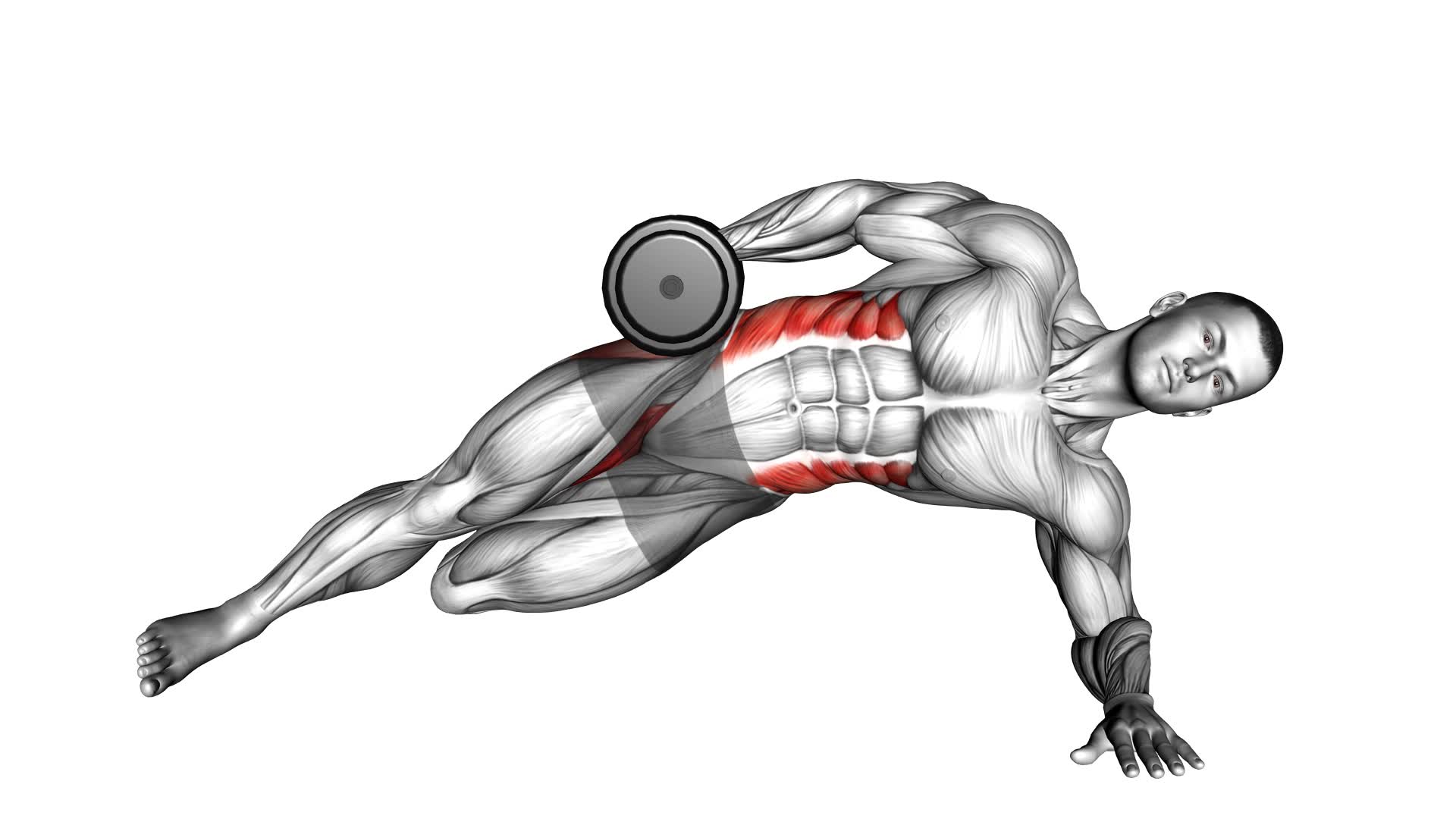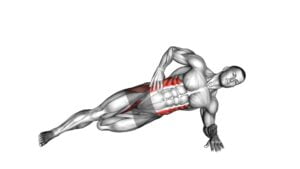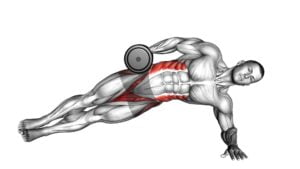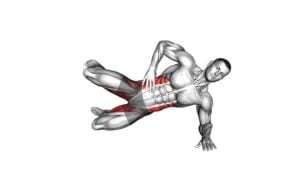Dumbbell Side Bridge With Bent Leg (Male) – Video Exercise Guide & Tips

Are you looking to strengthen your core and build stability?
Watch This Exercise Video
Then the Dumbbell Side Bridge with Bent Leg is the perfect exercise for you.
In this video exercise guide, we will show you the proper set-up, starting position, and step-by-step execution of this challenging move.
We will also share common mistakes to avoid and provide tips for maximizing your results.
Get ready to take your fitness routine to the next level with this effective core exercise.
Key Takeaways
- The dumbbell side bridge targets the obliques and transverse abdominis, improving core strength.
- It enhances stability, balance, and shoulder strength.
- The exercise helps prevent lower back pain and improves overall body control and coordination.
- Proper form and technique, along with gradually increasing the weight of the dumbbell, are important for maximizing results.
Benefits of the Dumbbell Side Bridge
The dumbbell side bridge offers a variety of benefits for individuals looking to strengthen their core muscles and improve shoulder stability. This exercise specifically targets the obliques, which are the muscles on the sides of your abdomen, as well as the transverse abdominis, the deep core muscle responsible for stabilizing your spine. By engaging these muscles, the dumbbell side bridge helps to improve your overall core strength, allowing for better stability and balance in your daily activities and athletic performance.
In addition to core strength, the dumbbell side bridge also helps to improve shoulder stability. As you hold the dumbbell in one hand and lift your body into the side bridge position, your shoulder muscles are activated to maintain proper alignment and control. This not only strengthens the muscles around your shoulder joint but also enhances your overall shoulder stability and mobility.
To maximize the benefits of the dumbbell side bridge, it's crucial to ensure proper set-up and starting position. Transitioning into the subsequent section, let's discuss the correct way to set up for this exercise and how to maintain proper form throughout.
Proper Set-Up and Starting Position
To properly set up for the dumbbell side bridge, position yourself on your side with your legs bent and one hand gripping the dumbbell. This starting position is crucial for maximizing the effectiveness of the exercise and preventing any unnecessary strain or injury.
Here are three key points to keep in mind:
- Core stability is of utmost importance in strength training. The dumbbell side bridge targets the muscles in your core, including your obliques, transverse abdominis, and quadratus lumborum. By maintaining a stable and engaged core throughout the exercise, you not only enhance your overall strength but also improve your posture and reduce the risk of lower back pain.
- For advanced athletes looking to intensify their side bridge routine, there are variations to consider. One option is to add resistance by using a heavier dumbbell or incorporating other weighted objects such as kettlebells or medicine balls. Another variation is to elevate your feet on a bench or stability ball, which increases the challenge on your core muscles.
- Remember to maintain proper form and alignment during the entire exercise. Keep your body in a straight line from your head to your heels, avoiding any sagging or twisting. Engage your core and focus on stabilizing your hips and shoulders.
Step-by-Step Execution of the Exercise
To properly execute the dumbbell side bridge, position yourself on your side with your legs bent and your hand gripping the dumbbell. Begin by lying on your side, ensuring your elbow is directly beneath your shoulder. Place your top foot in front of your bottom foot, creating a stable base. Engage your core and lift your hips off the ground, forming a straight line from your head to your feet. This is your starting position.
As you perform the dumbbell side bridge, you'll activate several key muscles. The primary muscle groups targeted include the obliques, quadratus lumborum, glutes, and shoulders. These muscles work together to stabilize and support your body in the side bridge position.
For beginners or individuals with limited mobility, modifications can be made to make the exercise more accessible. One modification is to perform the side bridge without the dumbbell. This reduces the load on the muscles and allows for a gradual progression. Another modification is to perform the exercise with your knees bent instead of your legs straight. This decreases the lever arm and makes it easier to hold the position.
Remember to breathe evenly throughout the exercise and avoid holding your breath. Aim to hold the side bridge for at least 20-30 seconds on each side, gradually increasing the duration as you gain strength and stability.
Common Mistakes to Avoid
Avoid these common mistakes when performing the dumbbell side bridge exercise to ensure proper form and maximize your results. Here are three key points to keep in mind:
- Maintaining alignment: One common mistake is allowing your body to sag or twist during the exercise. To avoid this, make sure your body forms a straight line from your head to your heels. Engage your core muscles and keep your hips lifted throughout the movement.
- Using appropriate weight: Another mistake is using a weight that's too heavy or too light for your current fitness level. Choose a dumbbell that challenges you without compromising your form. Start with a lighter weight and gradually increase the resistance as you become stronger and more comfortable with the exercise.
- Modifications and variations: It's important to understand that everyone's fitness level and body mechanics are different. If you find the exercise too challenging, try modifying it by performing the side bridge without a dumbbell or by bending both legs instead of just one. On the other hand, if you want to increase the difficulty, you can try adding a leg lift or performing the exercise on an unstable surface like a BOSU ball.
By avoiding these common mistakes and making necessary modifications and variations, you can ensure proper form and make the most out of your dumbbell side bridge workout.
Now, let's move on to the next section for tips on how to maximize your results.
Tips for Maximizing Your Results
Now let's continue with the previous point and focus on how you can maximize your results during the dumbbell side bridge exercise. To achieve the best outcome, it's important to pay attention to both your nutrition and workout intensity.
First, let's talk about nutrition tips. Fueling your body properly is essential for optimal performance and results. Make sure you're consuming a balanced diet that includes lean proteins, complex carbohydrates, and healthy fats. These nutrients provide the energy your body needs to perform at its best during the exercise. Additionally, staying hydrated is crucial for maintaining overall health and maximizing your workout potential. Drink plenty of water throughout the day, especially before and after your workout.
Next, let's discuss workout intensity. When performing the dumbbell side bridge exercise, it's important to challenge yourself. Gradually increase the weight of the dumbbell as you become stronger and more comfortable with the exercise. This will help to continually challenge your muscles and promote growth. Additionally, focus on maintaining proper form and technique throughout the exercise. This will ensure that you're effectively targeting the intended muscles and minimizing the risk of injury.
Frequently Asked Questions
How Many Sets and Repetitions Should I Do for the Dumbbell Side Bridge Exercise?
For the dumbbell side bridge exercise, you should aim to do 3 sets of 10-15 repetitions on each side.
This exercise is great for targeting your core muscles, especially the obliques, and improving stability.
By adding dumbbells, you can increase the intensity and challenge your muscles even more.
The dumbbell side bridge variations allow for progression and make the exercise more versatile.
Incorporating this exercise into your routine will help strengthen your core and improve your overall fitness.
Can I Perform the Dumbbell Side Bridge Exercise Without Using a Dumbbell?
Yes, you can perform the dumbbell side bridge exercise without using a dumbbell. There are alternative variations to add resistance such as using a resistance band or a weighted plate.
Adding resistance to the exercise can increase the difficulty and challenge your muscles even more. This can lead to greater strength and stability gains in your core and hip muscles.
Don't be afraid to experiment with different variations to find what works best for you.
Is the Dumbbell Side Bridge Exercise Suitable for Beginners?
Yes, the dumbbell side bridge exercise is suitable for beginners. It's a great exercise for strengthening your core and improving stability.
However, it's important to start with the basic version and gradually progress to more advanced variations.
Common mistakes in the dumbbell side bridge exercise include not maintaining proper form, using too heavy of a dumbbell, and not engaging the core muscles.
Remember to start slow and focus on proper technique to get the most out of this exercise.
Are There Any Alternative Exercises That Target the Same Muscles as the Dumbbell Side Bridge?
If you're looking for alternative exercises that target the same muscles as the dumbbell side bridge, there are a few options you can try.
One option is the side plank, which also engages the core and stabilizer muscles.
Another alternative is the Russian twist, which targets the obliques.
These exercises offer similar benefits to the dumbbell side bridge, such as improved core strength and stability.
Incorporating these alternatives into your routine can help provide variety and challenge your muscles in new ways.
Can the Dumbbell Side Bridge Exercise Help Improve Core Stability and Balance?
Yes, incorporating the dumbbell side bridge exercise into your full body workout routine can help improve core stability and balance.
This exercise targets your obliques, glutes, and hip muscles, making it an effective way to strengthen your core.
To perform it correctly, make sure to keep your body in a straight line, engage your core muscles, and use a weight that challenges you but allows for proper form.
Consistency and proper form are key to reaping the benefits of this exercise.
Conclusion
Incorporating the dumbbell side bridge with bent leg into your workout routine can provide numerous benefits, including improved core strength and stability.
By following proper set-up and execution techniques, you can maximize the effectiveness of this exercise.
Be sure to avoid common mistakes and consider implementing the tips provided to achieve optimal results.
Stay focused and committed to your fitness goals, and you'll see progress in no time.

Author
Years ago, the spark of my life’s passion ignited in my mind the moment I stepped into the local gym for the first time. The inaugural bead of perspiration, the initial endeavor, the very first surge of endorphins, and a sense of pride that washed over me post-workout marked the beginning of my deep-seated interest in strength sports, fitness, and sports nutrition. This very curiosity blossomed rapidly into a profound fascination, propelling me to earn a Master’s degree in Physical Education from the Academy of Physical Education in Krakow, followed by a Sports Manager diploma from the Jagiellonian University. My journey of growth led me to gain more specialized qualifications, such as being a certified personal trainer with a focus on sports dietetics, a lifeguard, and an instructor for wellness and corrective gymnastics. Theoretical knowledge paired seamlessly with practical experience, reinforcing my belief that the transformation of individuals under my guidance was also a reflection of my personal growth. This belief holds true even today. Each day, I strive to push the boundaries and explore new realms. These realms gently elevate me to greater heights. The unique combination of passion for my field and the continuous quest for growth fuels my drive to break new ground.







